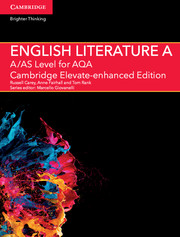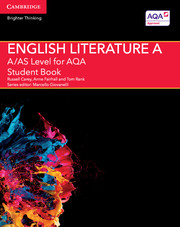A/AS Level English Literature A for AQA Digital Student Book (2 Years)
Overview
Written for the AQA A/AS Level English Literature A specifications for first teaching from 2015, this enhanced digital resource is suitable for all abilities. Helping bridge the gap between GCSE and A Level, the unique three-part structure provides essential knowledge and allows students to develop their skills through a deeper study of key topics whilst encouraging independent learning. Digital Editions include rich digital content such as video tutorials and extensive annotation tools. Available online and on tablet devices through the Cambridge Reader app.
Features
- The Digital edition is fully customisable and interactive, with text that can be annotated, rich and varied video content and auto-marked questions.
- The Digital edition also features a ‘My Work’ folder, enabling students to submit work and teachers to assess effectively, as well as track progress.
- Concise definitions of the key terms that students need to know are included and where possible accompanied with contextualised examples.
- Available online and on tablet devices through the Cambridge Reader app.
- Includes a range of activities to engage the learner.
- Regular self-assessment opportunities for students throughout each unit, helping students understand their areas of strength and improvement.
Contents
- Introduction
- BEGINNING:
- 1. Overview
- 2. Responding to literature
- 3. Texts, contexts and time
- 4. Wider reading, research and writing skills
- 5. Poetry
- 6. Prose
- 7. Drama
- DEVELOPING:
- 8. Love Through the Ages: Introduction
- 8.1 What is love?
- 8.2 Connecting love through the ages: Poetry
- 8.3 Connecting love through the ages: Prose
- 9. Love Through the Ages: Shakespeare
- 9.1 The Elizabethan era
- 9.2 Shakespeare's plays
- 9.3 Othello
- 9.4 The Taming of the Shrew
- 9.5 Measure for Measure
- 9.6 The Winter's Tale
- 10. Love Through the Ages: Poetry
- 10.1 Ideal, romantic love
- 10.2 Love, sex and inconstancy
- 10.3 Marriage and mature love
- 10.4 Love, loss and taboos
- 10.5 Bringing it all together
- 11. Love Through the Ages: Prose
- 11.1 Romantic love
- 11.2 Marriage and commitment
- 11.3 Love and death
- 11.4 Social conventions and taboos
- 11.5 Jealousy, guilt and remembrance 11.6 Bringing it all together
- 12. World War I and its Aftermath: Introduction
- 12.1 The Great War
- 12.2 The historical and social context
- 12.3 Memory and mourning
- 12.4 The pre-war cultural context
- 12.5 The aftermath
- 13. World War I and its Aftermath: Drama
- 13.1 The theatre of war and war in the theatre
- 13.2 R.C. Sherriff: Journey's End
- 13.3 Joan Littlewood and Theatre Workshop: Oh! What a Lovely War
- 13.4 Peter Whelan: The Accrington Pals
- 13.5 Richard Curtis and Ben Elton: Blackadder Goes Forth
- 13.6 David Haig: My Boy Jack
- 14. World War I and its Aftermath: Poetry
- 14.1 Poetry and remembrance
- 14.2 The age of chivalry
- 14.3 Which England?
- 14.4 Only connect: Finding the themes
- 15. World War I and its Aftermath: Prose
- 15.1 The novel before the First World War
- 15.2 Understanding the set texts
- 15.3 Rebecca West: The Return of the Soldier
- 15.4 Erich Maria Remarque: All Quiet on the Western Front
- 15.5 Ernest Hemingway: A Farewell to Arms
- 15.6 Susan Hill: Strange Meeting
- 15.7 Pat Barker: Regeneration
- 15.8 Sebastian Faulks: Birdsong
- 15.9 Sebastian Barry: A Long Long Way
- 15.10 Ben Elton: The First Casualty
- 15.11 Pat Barker: Life Class
- 15.12 Bringing it all together
- 16. Modern Times: Literature from 1945 to the Present Day: Introduction
- 16.1 Introduction
- 16.2 Education, education, education
- 16.3 Education and social mobility
- 16.4 Representation of class and gender in post-1945 literature
- 16.5 Representations of gender
- 16.6 The enduring influence of stereotypes
- 16.7 Exploring how Sylvia Plath portrays attitudes towards women in 'The Applicant'
- 17. Modern Times: Literature from 1945 to the Present Day: Drama
- 17.1 Introduction
- 17.2 The beginning of Miller's All My Sons
- 17.3 The moral implications of plays
- 17.4 Tennessee Williams: A Streetcar Named Desire
- 17.5 Tennessee Williams: Cat on a Hot Tin Roof
- 17.6 Making connections across genres
- 18. Modern Times: Literature from 1945 to the Present Day: Poetry
- 18.1 Poetry today
- 18.2 The poems in this unit
- 18.3 Poems about family relationships
- 18.4 Poems about relationships, their tensions and endings
- 18.5 Two poets exploring one day from different perspectives
- 18.6 Poetry about loss and grief
- 18.7 Bringing it all together
- 19. Modern Times: Literature from 1945 to the Present Day: Prose
- 19.1 The texts in this unit
- 19.2 Exploring Oranges Are Not the Only Fruit
- 19.3 Exploring The Handmaid's Tale
- 19.4 Exploring The Color Purple
- 19.5 Structure of novels
- 19.6 Prose questions in the examination paper
- 19.7 Bringing it all together
- 20. Texts Across Time
- 20.1 Why do a non-examined assessment?
- 20.2 The key requirements of the non-examined assessment
- 20.3 Choosing your texts
- 20.4 Selecting a theme for your comparison
- 20.5 Preparing for the assignment
- 20.6 Writing the first draft
- 20.7 The final draft
- 20.8 Unit summary
- ENRICHING:
- 21. Love Through the Ages
- 22. World War I and its Aftermath
- 23. Modern Times: Literature from 1945 to the Present Day
- 24. Texts Across Time
- Index
- Acknowledgements
Brighter Thinking Blog
Keep up to date with the latest classroom tips and educational trends from our brighter thinkers.
Visit the blogCatalogues and Ordering
Looking for something in particular or just browsing? View our catalogues to see our full range of print and digital books.
View and downloadAdvice on useful tools
Advice on useful tools, activities and timetabling from teachers experiencing school closures.
Cambridge GO
All our supporting resources have now moved to Cambridge GO – the new home for your Cambridge digital content.
Listen to our podcast
Listen to our podcast to discover teaching inspiration & advice from leading educational thinkers.








